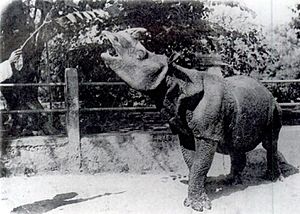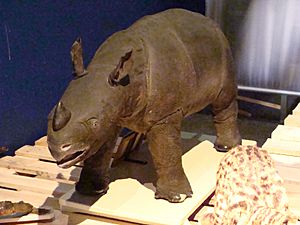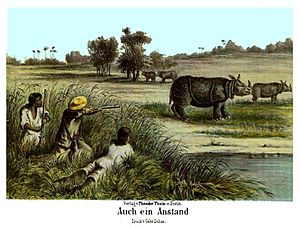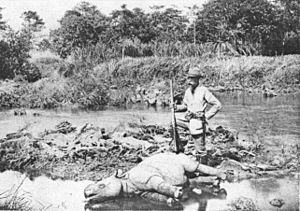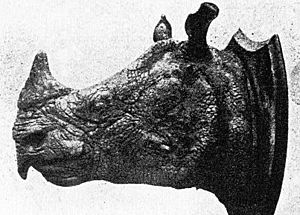Javan rhinoceros facts for kids
Quick facts for kids Javan rhinoceros |
|
|---|---|
 |
|
| R. s. sondaicus in the London Zoo from March 1874 until January 1885 | |
| Conservation status | |
| Scientific classification | |
| Genus: |
Rhinoceros
|
| Species: |
sondaicus
|
| Subspecies | |
|
|
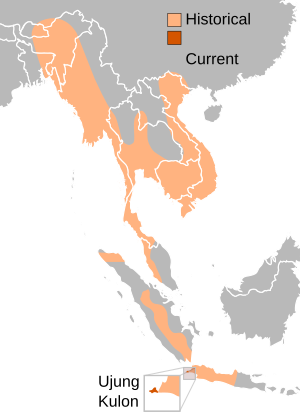 |
|
| Javan rhinoceros range | |
The Javan rhinoceros (Rhinoceros sondaicus), also called the Javan rhino or Sunda rhinoceros, is one of the rarest large animals on Earth. It is a type of rhinoceros and is one of only five rhino species still alive today. This rhino looks a bit like the Indian rhinoceros with its unique, armor-like skin folds.
Javan rhinos are smaller than Indian rhinos. They are about 3.1 to 3.2 meters (10 to 10.5 feet) long and 1.4 to 1.7 meters (4.5 to 5.5 feet) tall. Their horn is usually very short, less than 25 centimeters (10 inches). Only male Javan rhinos have horns; females do not have them at all.
These rhinos once lived across a huge area, from India and China all the way to the islands of Java and Sumatra. Sadly, they are now critically endangered. This means they are at a very high risk of disappearing forever. Today, the only known wild population lives in Ujung Kulon National Park on the island of Java in Indonesia. There are about 74 Javan rhinos left there.
The main reasons for their decline are poaching (illegal hunting) and habitat loss. Poachers hunt them mostly for their horns, which are used in some traditional medicines. Wars, like the Vietnam War, also destroyed much of their habitat. Even in the protected park, they face risks from poachers, diseases, and a lack of genetic diversity. Javan rhinos can live for about 30 to 45 years in the wild.
Contents
What's in a Name?
The name Rhinoceros comes from ancient Greek words. Rhís means 'nose' and kéras means 'horn of an animal'. So, it literally means 'nose-horn'. The word sondaicus comes from Sunda, which is a region in Southeast Asia that includes islands like Sumatra, Java, and Borneo. The Javan rhino is also known as the lesser one-horned rhinoceros because it has only one horn, unlike some other rhino species.
Rhino Family Tree
The Javan rhinoceros was first officially named Rhinoceros sondaicus in 1822 by a scientist named Anselme Gaëtan Desmarest. He studied a rhino from Java.
Scientists recognize three types, or subspecies, of Javan rhinos:
- R. s. sondaicus: This is the Indonesian Javan rhinoceros, found in Java.
- R. s. inermis: This was the Indian Javan rhinoceros, but it is now extinct.
- R. s. annamiticus: This was the Vietnamese Javan rhinoceros, which is also now extinct.
How Rhinos Evolved
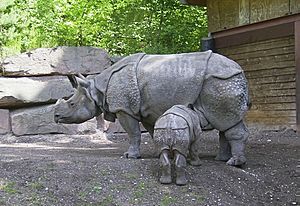
Rhinos are very old animals! Their ancestors first appeared in Asia a long, long time ago. The Indian and Javan rhinos, which are the only two species in the Rhinoceros group, first show up in the fossil record about 1.5 million years ago. Scientists believe they separated from each other even earlier, around 11.7 million years ago.
What They Look Like
Javan rhinos are smaller than Indian rhinos, but they are still very big animals. They are the largest animal on the island of Java. An adult Javan rhino can weigh between 900 and 2,300 kilograms (2,000 to 5,000 pounds). Males and females are about the same size.
Like the Indian rhino, Javan rhinos have only one horn. This horn is the smallest of all living rhinos, usually less than 20 centimeters (8 inches) long. The longest horn ever recorded was only 27 centimeters (11 inches). Only male rhinos have horns. Female rhinos do not have horns, though they might have a tiny bump. Javan rhinos don't seem to use their horns for fighting much. Instead, they use them to scrape mud, pull down plants to eat, and clear paths through thick forests.
Javan rhinos have a long, pointed upper lip. This helps them grab leaves and branches to eat. They also have sharp lower teeth that they use if they need to fight. Like all rhinos, they have excellent hearing and smell, but their eyesight is not very good. They are thought to live for 30 to 45 years.
Their skin is hairless and looks gray or gray-brown. It falls in folds around their shoulders, back, and rump, giving them an "armored" look. Because these rhinos are so rare and shy, scientists rarely study them up close. Instead, they use camera traps and collect poop samples to learn about their health and behavior. This makes Javan rhinos the least studied of all rhino species.
Where They Live
There are fewer than 100 Javan rhinos left in the wild. They are considered one of the most endangered species in the world. The only place they are known to survive is in Ujung Kulon National Park on the western tip of Java.
In the past, Javan rhinos lived in many places across Southeast Asia, including India, Myanmar, Thailand, Vietnam, and the islands of Sumatra and Java. They prefer to live in dense, lowland rain forests, wet grasslands, and areas with many rivers and mud wallows.
Their habitat has been shrinking for thousands of years as human settlements grew. They disappeared from India in the early 1900s and from the Malay Peninsula by 1932. The last ones on Sumatra died out during World War II. By the end of the Vietnam War, the Vietnamese Javan rhino was thought to be extinct. However, a small group was found in Vietnam in the late 1980s. Sadly, the last known Vietnamese Javan rhino was shot by poachers in 2010, and the species was declared extinct in Vietnam in 2011.
How They Behave
Javan rhinos are mostly solitary animals. This means they live alone, except when mothers are raising their calves or when males and females come together to breed. Sometimes, small groups might gather at salt licks or mud wallows. Wallowing in mud is important for rhinos. It helps them stay cool and protects their skin from diseases and parasites. Javan rhinos usually don't dig their own mud wallows; they prefer to use existing pits and make them bigger with their horns. Salt licks are also very important because rhinos get essential nutrients from the salt.
Male rhinos have larger home ranges than females. Males mark their areas with piles of dung and by spraying urine. They also scrape the ground with their feet and twist young trees to communicate with other rhinos.
Javan rhinos are very quiet compared to other rhino species. Scientists have recorded very few sounds from them. Adult Javan rhinos have no natural predators except humans. They are very shy and will retreat into thick forests if humans are nearby. This shyness makes them hard to study. However, if a human gets too close, a Javan rhino can become aggressive and attack using its sharp lower teeth.
What They Eat
The Javan rhinoceros is a herbivore, meaning it eats only plants. They eat many different types of plants, especially young shoots, twigs, fresh leaves, and fallen fruit. They often knock down small trees to reach their food and use their flexible upper lip to grab it. They are very adaptable eaters. It is estimated that a Javan rhino eats about 50 kilograms (110 pounds) of food every day. Like the Sumatran rhino, they need salt in their diet. Since there are no natural salt licks in Ujung Kulon, the rhinos there have been seen drinking seawater to get the salt they need.
Saving the Javan Rhino
The biggest reason for the Javan rhino's decline is poaching for its horn. Rhino horns have been traded for over 2,000 years in China, where some people believe they have healing powers. Historically, rhino hide was also used to make armor for soldiers. Because many people living near rhino habitats are poor, it's hard to stop them from killing an animal that can be sold for a lot of money.
The international trade of Javan rhinos and their products has been banned since 1975 by the Convention on International Trade in Endangered Species. Despite this, rhino horn can still be sold illegally for very high prices.
Losing their habitat due to farming has also hurt the rhinos, but this is less of a problem now that they only live in a protected park. Even with all the efforts to save them, their future is still uncertain. Because the entire population lives in one small area, they are at high risk from diseases and from inbreeding, which happens when animals that are too closely related breed. Scientists believe that at least 100 rhinos are needed to keep their genes healthy and diverse.
Ujung Kulon National Park
The Ujung Kulon peninsula in Java was badly damaged by the eruption of the Krakatoa volcano in 1883. After the eruption, Javan rhinos moved back into the area, but humans did not return in large numbers. This made it a safe place for wildlife. In 1931, the Javan rhino became a legally protected species.
The first count of rhinos in Ujung Kulon was in 1967, and only 25 animals were found. By 1980, the population had doubled to about 50, and it has stayed around that number since then. Although there are no natural predators for the rhinos in Ujung Kulon, they have to compete for food with wild cattle. This might keep their numbers from growing larger.
In 2011, hidden cameras filmed adult and young rhinos, showing that they were still breeding. From January to October 2011, cameras captured images of 35 different rhinos. In 2012, more cameras were added to better track the rhinos and estimate their population size.
Scientists are also working to remove the arenga palm from the park. This plant is growing too much and crowding out the plants that rhinos eat. By studying rhino trails, researchers have learned about their eating habits and how they use wallow holes.
In 2017, there were plans to move some rhinos to another wildlife sanctuary in West Java. This would help create a second population, which is important in case something bad happens to the rh rhinos in Ujung Kulon. However, these plans have not happened yet. In December 2018, the remaining Javan rhino population faced a new danger from a tsunami caused by the nearby volcano Anak Krakatoa.
Cat Tien National Park (Vietnam)
The Javan rhinoceros was thought to be extinct in Vietnam by the mid-1970s, after the Vietnam War. The war caused a lot of damage to the environment.
However, in 1988, a hunter shot a female rhino, proving that the species had somehow survived. Scientists then searched Vietnam's southern forests and found fresh tracks of up to 15 rhinos. Because of these rhinos, the area they lived in became part of Cat Tien National Park in 1992.
By the early 2000s, it was feared that the rhino population in Vietnam was too small to recover. Some experts thought only three to eight rhinos were left. Sadly, in May 2010, the body of a Javan rhino was found in the park. It had been shot, and its horn was removed by poachers. In October 2011, it was confirmed that the Javan rhinoceros was extinct in Vietnam, leaving only the rhinos in Ujung Kulon.
In Zoos
A Javan rhinoceros has not been seen in a zoo for over 100 years. In the 1800s, at least four rhinos were kept in zoos in cities like London and Calcutta. However, Javan rhinos never did well in captivity. The oldest one lived to be only 20 years old, which is about half the age they can reach in the wild. No Javan rhino has ever given birth in a zoo. The last Javan rhino in captivity died at the Adelaide Zoo in Australia in 1907.
In Culture
Javan rhinos were once found in Cambodia. There are at least three pictures of rhinos carved into the walls of the Angkor Wat temple.
A Javan rhinoceros named Kaka was one of the mascots for the 2018 Asian Games. Another Javan rhinoceros named Bacuya was the mascot for the 2023 FIFA U-20 World Cup.
See also
 In Spanish: Rinoceronte de Java para niños
In Spanish: Rinoceronte de Java para niños



